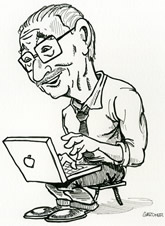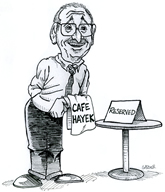Here’s a letter to a former student of mine.
Eric:
Thanks for your email.
You write that you “understand tariffs raise some prices and lower others which is why economists don’t call tariffs inflationary. Instead economists say tariffs reduce the economy’s productivity and the number of goods consumers can buy. But if the supply of money doesn’t change, we get the same amount of money chasing fewer goods. Inflation should happen.”
Your confusion is nothing to apologize for. We economists (including me) often are unclear on this front.
Part of the problem is ambiguity about what is meant by “inflation.” If what is meant is a sustained, on-going rise in the price level, even the most draconian tariffs will not be inflationary, even though they might cause a noticeable rise in the price level. That rise, however, would not be sustained. It would be a one-time event.
Consider the extreme case of tariffs set so high as to block all imports into the U.S. The result would be a noticeable one-time rise in the price level (although, practically, official data might take two or three months to fully capture this reduction in the dollar’s purchasing power). This inflation wouldn’t be the month after month after month, running into years, sort of price hikes that Americans experienced in the 1970s and that most people still think of as inflation. This latter, familiar sort of inflation is caused by the monetary authority issuing new money in excess of the demand to hold money. This is the inflation that Milton Friedman had in mind when he wrote that “inflation is always and everywhere a monetary phenomenon.”
An important difference between price-level increases that are caused by monetary mismanagement and those that are caused by tariffs is that, at least in principle, when inflation that’s caused by excess money creation ends, that inflation leaves all relative prices unchanged: the price of a cup of coffee at Starbucks rises from $3.00 to $3.30, the price of the Camry rises from $30,000 to $33,000, the price of the condo rises from $300,000 to $330,000, and the worker’s hourly wage rises from $30.00 to $33.00. Not so with tariffs, which permanently raise the prices of protected goods relative to the prices of unprotected goods and services. Indeed, this change in relative prices is a chief reason why protective tariffs cause economic inefficiency.
One might insist that, because protective tariffs do indeed reduce the purchasing power of the currency, they should be called inflationary. Two good reasons counsel against this labeling. The first is that any economically harmful government intervention – of which there are many – reduces productivity and the quantity of outputs available for people to buy. Yet we don’t slap the label “inflationary” on the likes of high taxes, occupational-licensing restrictions, land-use regulations, or antitrust interventions, all of which make businesses less efficient. These and countless other government interventions inflict economic damage very much like that which is inflicted by protective tariffs. But because none of these interventions results in a sustained, on-going fall in the dollar’s purchasing power, they are understandably not labeled “inflationary.”
Second, trade in the U.S. directly makes up less than one-fifth of our economy, and the statistical techniques for measuring inflation are unavoidably imperfect. As a result, conventional inflation measures are unlikely to accurately detect the positive difference between the prices that rise as a result of the tariffs and the prices that fall as a result of the tariffs. That difference will be real and in the actual economy, but it will be mixed in with all the many other changes in the economy. The measurement tools are simply too crude to isolate the effects of the tariffs and detect this difference.
Apologies for the length of my reply, but your question is an excellent one that deserves a careful and full response. I hope this helps.
Sincerely,
Don



